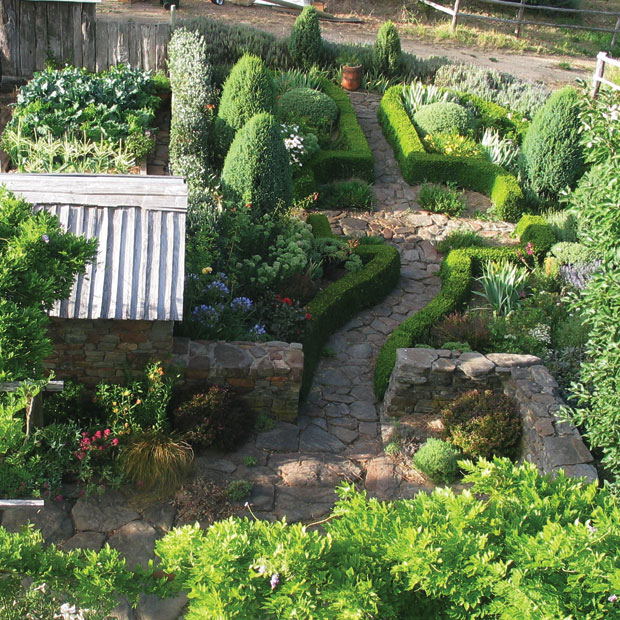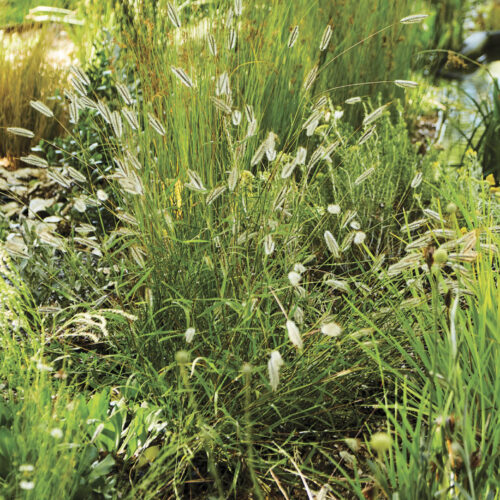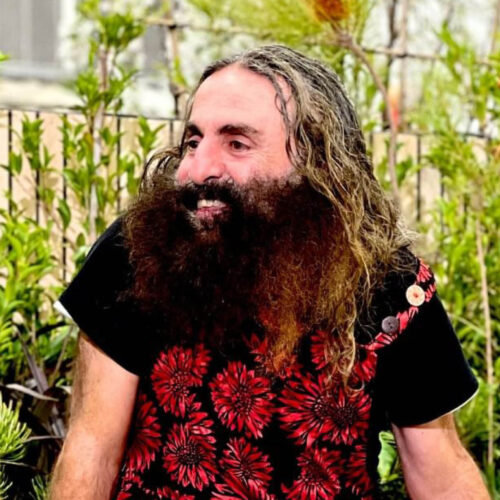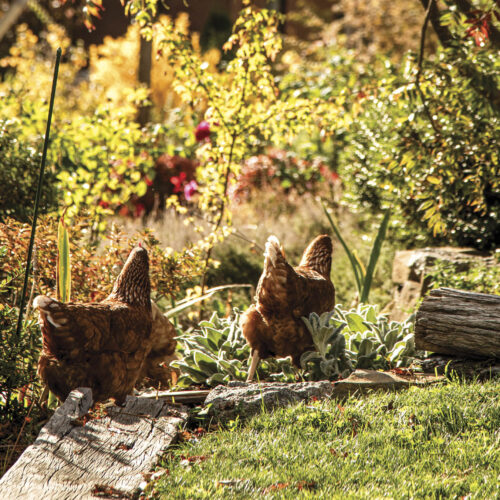Beautiful by design
2011-09-30T08:53:54+10:00
Garden designer Steve Hailstone has combined beauty and functionality to create a wonderfully productive property, writes SIMON WEBSTER.
How do you want life in your garden to be?” This is the important question garden designer Steve Hailstone asks his clients. “I’ve worded it carefully,” he says. “How do you want your lives to be? How do you want the ecosystem to function? How do you want to experience it? How do you want to feel about it? That’s why I say ‘life’, not just ‘your life’. It’s a very powerful question.”
It’s a question that Hailstone has constantly asked himself as he has developed his own one-hectare property in the Adelaide Hills over the past 23 years. From an overgrazed paddock with three large blackberry patches, ‘Niwajiri’ (from a Japanese word roughly meaning ‘spirit of gardening’) has been transformed into a place that not only provides an abundance of food but is diverse and stunningly beautiful.
The property provides 80 per cent of the household’s fruit and vegetables, as well as eggs and meat. But for Hailstone, aesthetics cannot be compromised. Growing food in an ugly garden is out of the question.
Permaculture pros and cons
Hailstone, 54, has lived in this district since he was 14 and says that ever since his teens he had been looking for a block of land with good soil and water and as cold as possible so he could grow cool-climate ornamentals. “I had enthusiasm for English and Japanese gardens,” he says. “My aspirations have evolved a lot since then.”
A permaculture course taught by the movement’s co-founder, David Holmgren (holmgren.com.au), shortly after Hailstone moved to ‘Niwajiri’, changed everything. It was an experience Hailstone describes as “mind-blowing”, giving him a design system that matched his aspirations for being productive and environmentally friendly, and making him want to rip out all his exotic ornamentals and start again.
Hailstone’s mother encouraged him to be more circumspect, and not to destroy his hard work. It was advice for which he remains grateful, because while permaculture continues to inspire Hailstone, it turns out that the riot of apparent chaos that permaculture can become is not how he wants life in his garden to be.
“Permaculture design principles, such as ‘working with nature rather than against it’, and ‘every element should perform a number of functions, while every important function is supported by a number of elements’, are all extremely sensible,” says Hailstone.
“Beauty is an important function to us as well though,” he says, speaking for himself and his partner, Chris. This beauty is found in plants, sounds, textures, smells, wonderful organic food, the ‘garden pictures’ provided through windows from the house, as well as the areas for shared meals and conversation, and those for quiet meditation.
A lecture by environmentalist Allan Savory on holistic management was the final piece in the puzzle. Hailstone says this system of farm management recognises that while all living beings follow patterns, each situation is different. “Together, permaculture and holistic management are a powerful combination.”
However, he says many people fail by treating permaculture models as gospel when in fact “every situation, every farm, every backyard, every family is unique”.
The vegie patch
At ‘Niwajiri’, order and beauty also bring bounty. Detailed records of crops harvested and groceries bought show that produce grown on the property has reduced the household food bill by two-thirds.
The vegie patch has a lot to do with that. Four raised beds made from railway sleepers are subdivided to make beds within beds. These are watered by hand or via a drip system that has numerous taps so different sections can be isolated.
“Tomatoes, aubergines and capsicum need a slow, deep soak and we use drippers,” says Hailstone. “But there’s no point turning on the dripper system for seedlings that are only 50mm high if it’s also watering 6-foot high tomatoes. In our soil you’ll drown them and also it’s a waste of water so you may as well water by hand.”
The soil in question is an acidic clay loam that Hailstone has improved with frugal additions of compost, lime and dolomite in food-producing areas.
“Some people in the organic movement say you just add compost, but you can create toxicity by adding too much and lock up nutrients. We’ve put a lot of effort into the vegie patch because without the right balance vegies don’t grow very well, are more susceptible to diseases and the nutritional value is not there.”
Raised beds are not right for every situation, Hailstone says, and are an expensive option due to the materials involved. However in his clay soil and wet-winter climate, improving drainage is crucial, and after a few experiments he finds the 400mm-high sides of the raised beds to be ergonomically comfortable too.
The vegie patch has a chequered past, having been moved twice. Its third position is hopefully its last, Hailstone says. “The location we’ve got now is about as good as we can reasonably get without relocating the house.”
The site for vegie patch No.1 was chosen because of its proximity to the house – just across a patio, and visible from the main windows. However, when Hailstone’s landscaping business commitments took precedence over home-grown vegies for a while, the patch became an eyesore. “It looked horrible. It was an awful mass of weeds. So it had to move.”
The second location was near the chook house, which was great for integrating chickens, but too far from the house to ensure it got attention.
Finally, the vegie patch is in the perfect position: close to the kitchen but partly hidden from view by a greenhouse and outdoor kitchen. It’s close to where Hailstone parks his car, making it easy to offload materials such as mulch, and ensuring the patch gets looked at often. Hailstone says it’s worth getting the vegie patch right: when he has calculated his hours spent in there and the value of vegies produced, he works out that he’s getting paid the equivalent of $20-$30 an hour. Tax-free, of course.
Chooks on the move
The property’s many elements are constantly being refined. The small flock of Cochin chickens (good for meat as well as egg-laying, Hailstone says) was completely free-ranging but did too much damage. The flock then went into a chook tractor that was dragged from place to place, but that got too hard. The birds are now in a chook wagon, raised on motorcycle wheels, that has been designed to be easy to move around. Laying boxes and roosts (branches of pest-resistant Cypress pine) are at a height that makes maintenance easy to do while standing up.
“I’m in my mid 50s and my partner’s nearly 50,” says Hailstone. “We’ll be here when we’re 90 and I still want to be able to run the place.”
The wagon attaches to a central chook shelter with a secure deep litter run and several grassed areas off it. The chooks are rotated through these different runs, and sometimes wheeled to other parts of the property as and when they can do a job there: the orchard, for example.
However, Hailstone cautions against running poultry permanently in a citrus orchard. “I’ve seen so many orchards trashed because citrus trees have got surface roots and chooks wreck the roots.”
A bountiful orchard
The “reasonably traditional” orchard is at times occupied by sheep as well as chickens as part of the animal grazing rotations. Apples, pears, plums, peaches, nectarines, cherries, quince, mulberries, crab-apples, raspberries and redcurrants ensure the household is never short of vitamins.
There’s also a 30-metre-long row of boysenberries, producing 50 kilograms of fruit a year. They are grown on a trellis offset from an internal fence so that sheep can reach through and eat the grass but not reach the berries. This set-up also leaves room for the plants to be netted to protect them from birds, just like all the fruit in the orchard. “Any fruit we don’t net, we don’t get.”
Holistic grazing
A flock of about 70 Dorper sheep provides a modest income from meat sales. Under the holistic grazing management system, the sheep spend short amounts of time in small paddocks, mimicking the movements of closely packed groups of ruminants in the wild.
The paddocks are hit hard by the sheep but then given a good amount of time to recover. The results, Hailstone says, include improved soil health, grass growth and productivity. The system leads to deeper soils, full of organic matter, which means tonnes of carbon have been sequestered. The one hectare property has only 6000 square metres of pasture divided into eight paddocks, so the sheep are also agisted nearby as part of the rotation plan.
A sense of authenticity
“Authenticity” is important to Hailstone. “Authenticity” or “realness” or “connection” enhances beauty, he says. But
that authenticity can take any form the gardener likes.
Hailstone’s property has stonework (using local stone) reminiscent of the Yorkshire Dales, in northern England, because his favourite show as a child was All Creatures Great and Small. That landscape resonates with him, even though he has never visited it. Hailstone loved how the built landscape in the Dales – walls, paving, roads and fences – were made of local stone, providing a sense that “every element belonged and was at home in its landscape”. He feels the same way about the early settlers’ barns and cottages of the Adelaide Hills, with their timber beams and worn floorboards.
‘Niwajiri’ also has Japanese gardens because Hailstone and his partner love the Japanese aesthetic and are interested in the culture.
“We don’t have an authentic Japanese garden – I don’t think you can unless you’re Japanese and in Japan – but it’s authentic to us.”
After 30 years as a garden designer Hailstone has concluded that following the dictates of “prescriptive how-tos and political correctness or fashion” will only end in tears. The key is choosing layouts, plants and materials that have connection and meaning for the people who will be spending time in the garden.
“Here there are stone walls and in them I can see the different personalities of the two blokes who built them. It doesn’t mean diddly-squat to anyone else but it’s meaningful for me. It’s an authentic connection.”






